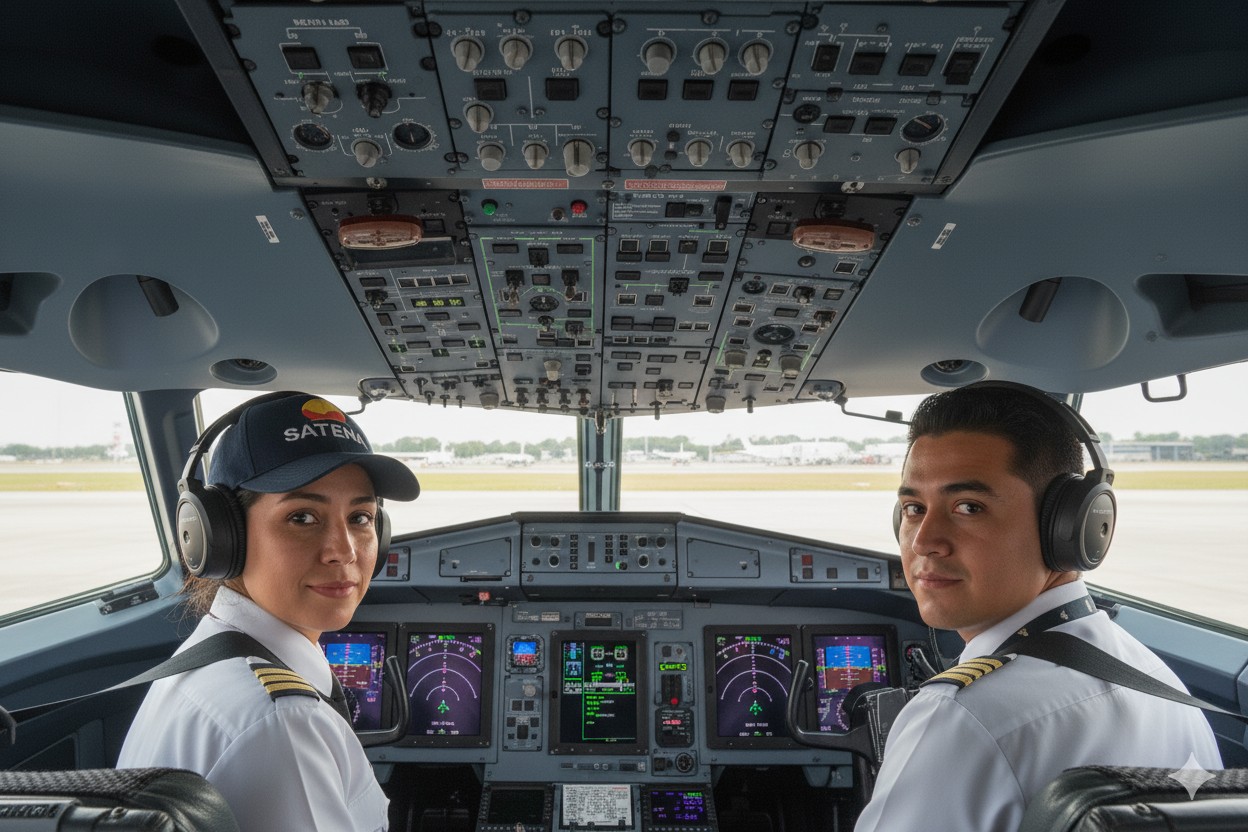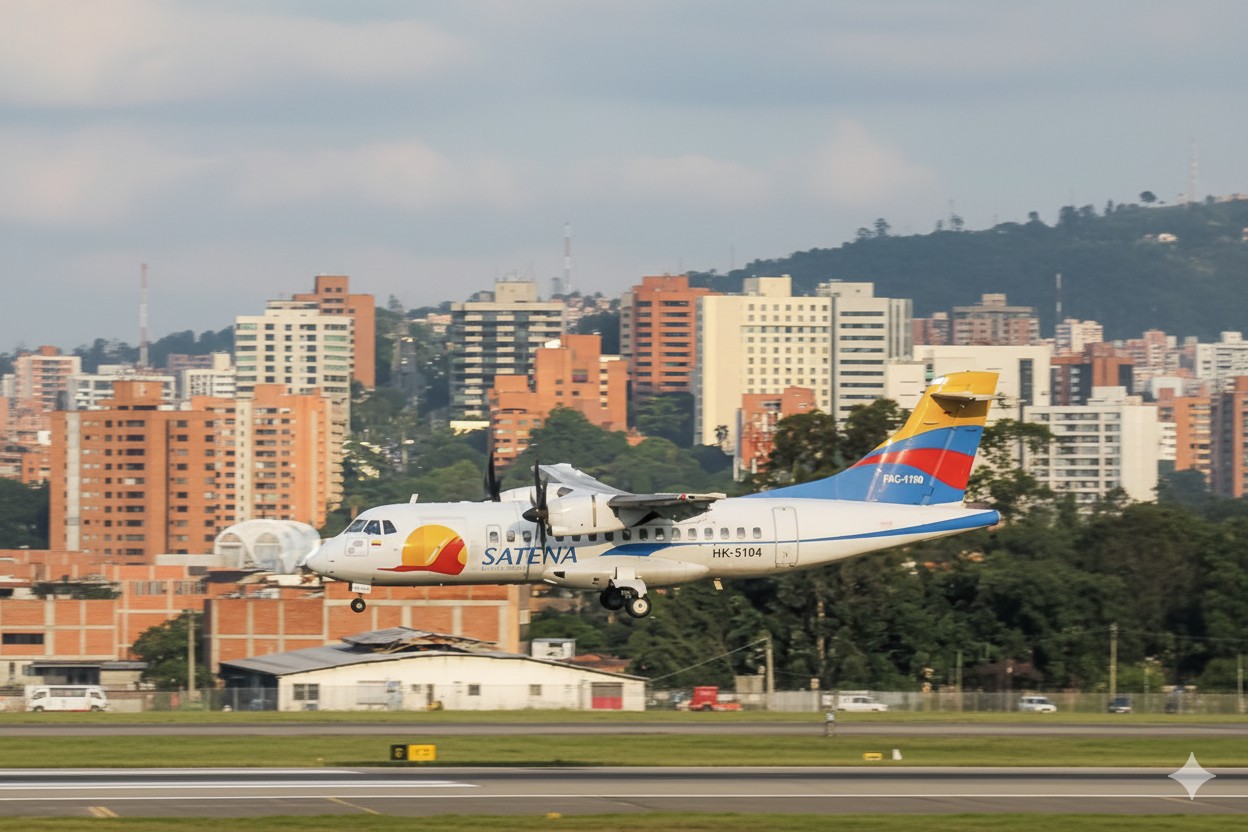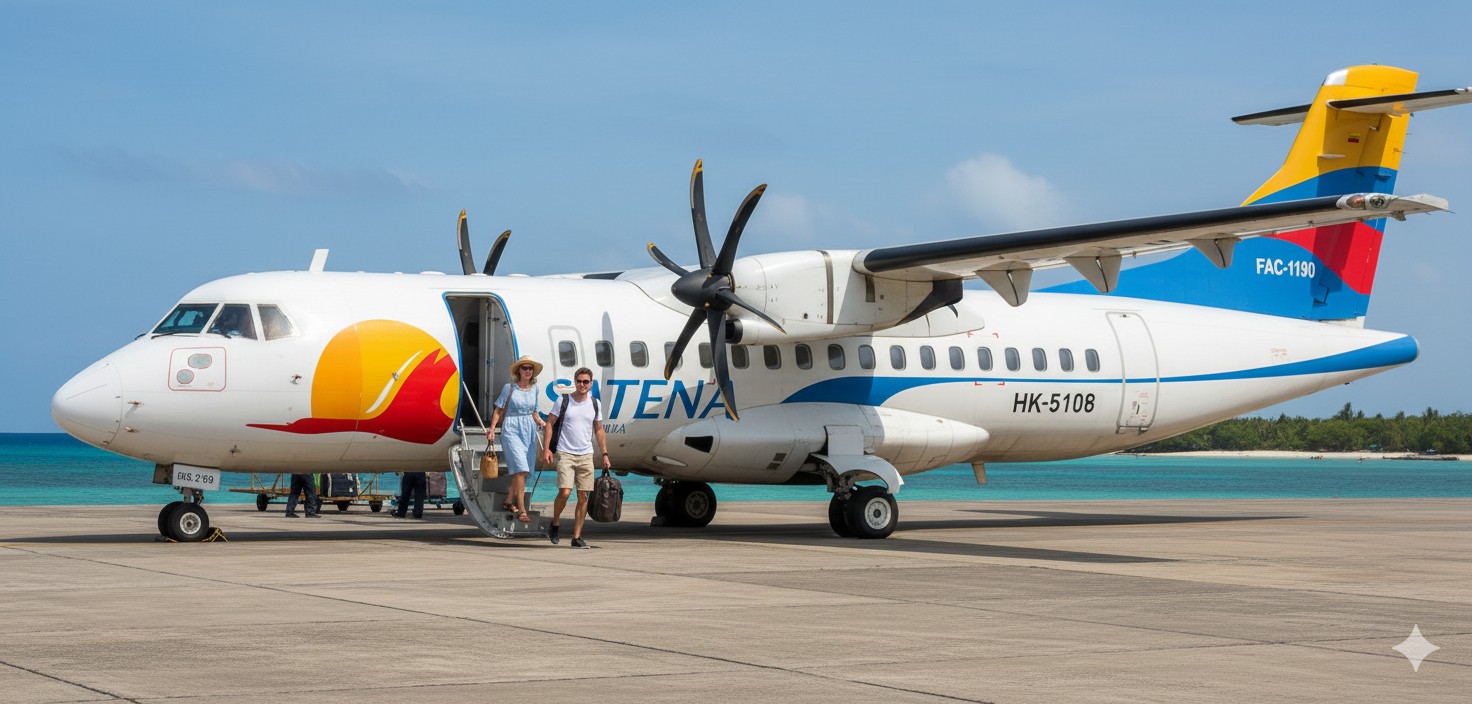October 21, 2025
 SATENA: Colombia’s Government-Backed Connector
SATENA: Colombia’s Government-Backed Connector
If you’ve never flown SATENA before, it’s likely because this airline doesn’t compete on big international routes. SATENA (Servicio Aéreo a Territorios Nacionales) is a Colombian airline owned by the government and operated under the supervision of the Colombian Air Force.
Its mission is different from Delta, United, or American. Rather than focusing on global hubs, SATENA’s role is to connect remote and underserved parts of Colombia — jungles, border towns, smaller regional cities, places where road or river travel might be hard or slow.
So when you fly SATENA, you’re stepping into a niche regional world. We decided to travel on one of its domestic routes to see how it stacks up to U.S. carrier norms: fares, seats, amenities, baggage, reliability, and where it shines or falters.
Want to know precisely how Satena compares to other budget airlines? Here’s our info box.
Booking & Fare Structure
Because SATENA operates domestically within Colombia (and limited neighboring coverage), its fare system is simpler than those of major U.S. airlines. There are generally fewer tiers or premium classes; most flights are in “economy” or a single class.
Still, differences appear depending on the route (some are more remote, more logistically difficult) and the type of aircraft (some small planes, some larger turboprops). For a traveler used to U.S. legacy fare brands (Basic Economy, Main Cabin, First), the contrast is that SATENA’s “all-economy” model means fewer options for upgrades or class swapping.
In our booking trial, the base fare often includes a modest amount of baggage and a carry-on, but the space is tight and restrictions are enforced strictly. SATENA does not appear to offer seat upgrades or premium seats in most cases; you select your seat if possible, but in many small routes the aircraft is filled and seat choice is limited.
The ticket cost is often fairly low relative to driving or regional alternatives, because SATENA fills a gap of access. But unlike U.S. carriers, the “extras” (baggage, changes) are less flexible. In short: you don’t get many bells and whistles when booking with SATENA. The core fare largely reflects just getting you from point A to B in remote territory.
Aircraft, Seats & Cabin Experience
 Because SATENA serves remote or regional destinations, it uses turboprop aircraft and small regional planes. Its fleet includes ATR 42, ATR 72, Embraer ERJ-145, and Twin Otter planes designed for short runways and rugged conditions.When we flew on one of its shorter routes, we found the seats to be basic and functional. They are similar to what you see on regional U.S. flights: narrow, not much padding, limited recline, and simple seatback (or no seatback) features. One Flight-Report reviewer on a short San Andrés flight wrote:
Because SATENA serves remote or regional destinations, it uses turboprop aircraft and small regional planes. Its fleet includes ATR 42, ATR 72, Embraer ERJ-145, and Twin Otter planes designed for short runways and rugged conditions.When we flew on one of its shorter routes, we found the seats to be basic and functional. They are similar to what you see on regional U.S. flights: narrow, not much padding, limited recline, and simple seatback (or no seatback) features. One Flight-Report reviewer on a short San Andrés flight wrote:
SATENA’s crews are some of the kindest we’ve met in Colombian aviation. They might not have the polished style of bigger airlines, but they compensate with genuine care. When one of our bags was left behind in Bogotá, the attendant took our information personally and called us the next day to confirm delivery.
We’ve also noticed how grounded and human the service feels. Agents don’t hide behind corporate policies; they explain things face to face. When we flew out of Villavicencio, the check-in officer helped a family redistribute luggage weight so they wouldn’t have to pay extra.
One challenge: consistency. Some aircraft are newer or refurbished, others are older. You might get a bit more comfort on a newer ATR 42 than on a small Twin Otter. But you should expect the modest end of comfort, especially for regional service.
Entertainment, Connectivity & Amenities
One area where SATENA decidedly lags behind U.S. carriers is in entertainment and connectivity. On our flights, there was no Wi-Fi, no streaming portal, and no seatback screens. Now, before you tag this as a dealbreaker, this is fairly common on very short regional flights. But for travelers used to bigger airlines where Wi-Fi is standard (or at least available) on many flights, it feels like a big gap.
You might bring your own device, but don’t expect the airline to offer movies or music. There is no buy-on-board entertainment or app streaming service. The lack of amenities is a reminder that SATENA’s mission is connectivity over comfort.
There is also no consistent meal service on these short flights. On some longer domestic legs, a snack or drink might be offered, but don’t count on a full hot meal in economy.
Baggage, Carry-on & Fees
This is one of the parts where SATENA’s rules are strict and you must pay attention. Because the aircraft are small and weight matters, SATENA enforces baggage limits tightly.
According to SATENA’s official policy, each passenger may carry one (1) piece of hand luggage with maximum dimensions 43 cm high × 34 cm wide plus one personal item. The weight for carry-on is capped at 5 kg.
If your carry-on is heavier than 5 kg or exceeds dimensions, it might be rejected or forced into checked baggage (if possible). The airline explicitly notes it does not accept carry-on items exceeding those limits, and does not assume liability beyond legal limits for such over-limit items.
For checked baggage, many SATENA tickets include 15 kg of free checked baggage. If you have more weight or oversized items, you may face extra fees.
One baggage forum discussion about the San Andrés to Providencia route states that hold baggage is limited to 10 kg and carry-on to 5 kg, with no excess allowed. That suggests that in some routes, especially small remote ones, the regulations might be even stricter than the general rules.
We observed during boarding that staff sometimes weighed carry-ons at the gate, and would ask travelers with heavier bags to recheck them. That kind of gate enforcement is rarer on large carriers, where baggage allowances tend to be more generous or flexible.
If you bring expensive items, keep them in your hand luggage under the limit, because SATENA disclaims liability for over-limit items. Always bring a scale and measure dimensions if you’re flying SATENA, because you don’t want surprises at boarding.
Service, Crew & Ground Staff
 Despite its modest infrastructure, one of SATENA’s strengths is the humanity of the people who run it — especially on remote routes, the crews tend to be friendly and accommodating under tough conditions.
Despite its modest infrastructure, one of SATENA’s strengths is the humanity of the people who run it — especially on remote routes, the crews tend to be friendly and accommodating under tough conditions.
Passengers often mention the dedication of the pilots and crew, especially in difficult terrain or weather. One blog recounts that takeoff and taxiing are often swift (because few passengers), and that crew passion is evident.
Also, the Champagne Mile review criticizes the ticketing process and suggests that some aircraft (like those serving Providencia) need modernization.
Compared to U.S. carriers, where service style is heavily standardized (scripted greetings, uniform procedures), SATENA’s service can feel more ad hoc — sometimes warm, sometimes abrupt. You’ll have to rely more on flexibility and patience.
Reliability, Delays & Operational Challenges
One of the biggest challenges for SATENA is reliability. Serving remote and regional routes means flights are vulnerable to weather, mechanical constraints, and tight schedules. Many user reviews point to frequent cancellations or delays, especially on less-trafficked routes.
We learned early on that with SATENA, weather decides everything. One of our return flights from the Amazon was delayed nearly three hours due to poor visibility in Bogotá. Instead of leaving us guessing, the airport agent came out and explained that the aircraft hadn’t departed yet for safety reasons.
On another trip, one of our friends had a connection canceled in Quibdó because fog closed the runway. The airline provided hotel vouchers and rebooked passengers for the next morning. It wasn’t convenient, but it was handled calmly and transparently.
SATENA’s operations can feel unpredictable, but that’s the reality of flying into regions with unstable weather and limited infrastructure. You learn to pack patience along with your luggage.
In the median, on Flight-Report, SATENA has an average rating of 6.7/10. Strengths include cabin comfort, but weaknesses include crew service and in-flight amenities, a disadvantage we already covered with the lack of entertainment offer..
Because routes are remote, backup aircraft may be limited — a delay in one leg can cascade into multiple disruptions. Passengers have complained of long waits at the airport, lack of clear coordination, and limited recourse.
In contrast, U.S. airlines, while not immune to delays, often have more redundancy, spare aircraft, and robust customer systems for rebooking and notifying travelers. With SATENA, you may find yourself waiting at a small regional terminal with limited support.
Safety & Incidents
By modern standards, catastrophes are rare, and SATENA follows Colombian and international safety regulations. Still, flying into remote airports increases inherent risk, so you should prefer newer aircraft, daylight flights, and stable weather windows where possible.
In terms of safety, SATENA has a long operating history, but given its operations in difficult terrain it has had incidents. One notable one is Flight 9634 in 2010: an Embraer 145 overran the runway at Mitú due to approach issues and wet runway conditions. Passengers escaped without fatalities.
What Works Well & What Doesn’t
Let’s break down what impressed us, and what raised red flags, especially from the viewpoint of someone used to U.S. carriers.
What Works Well
 Connectivity to remote regions: SATENA fulfills a unique role that big airlines can’t—in many parts of Colombia it is the only regular air option.
Connectivity to remote regions: SATENA fulfills a unique role that big airlines can’t—in many parts of Colombia it is the only regular air option.
Low base fares on remote routes: For access to hard-to-reach places, the cost is often far lower than alternative overland journeys.
Courageous crews: Operating in tough topography and weather, crews often show resourcefulness.
Quick boarding in small terminals: Because flights are small, boarding and disembarkation can be fast. Some reports mention swift taxiing and low waiting times.
Transparency in baggage limits: At least the carry-on rules are stated clearly on the airline’s site: 5 kg and 43×34 cm.
What Frustrates
No Wi-Fi or entertainment: For all but the shortest journeys, the lack of connectivity and in-flight entertainment feels stark.
Strict baggage limits and enforcement: The 5 kg carry-on cap is tight. Many U.S. travelers will find it restrictive.
Older aircraft & varying comfort: Some planes are older, seats are basic.
Limited recourse in disruptions: In small terminals, agents and resources for rebooking or customer support may be minimal.
Comparing SATENA to Other Budget LATAM Airlines
| Category | SATENA | Wingo | JetSMART |
| Airline Type | State-owned regional carrier (connects remote Colombian towns) | Colombian low-cost carrier (owned by Copa Holdings) | South American ultra-low-cost carrier (Indigo Partners) |
| Primary Network | Domestic Colombia + remote routes | Colombia + Caribbean/Central America | Chile, Peru, Argentina, Colombia + regional internationals |
| Fare Model | Simple economy; few upgrades | Ultra-low base fare + paid add-ons (bundles available) | Ultra-low base fare + paid add-ons (bundles: SMART/Full) |
| Free Bags | Often includes 1 checked bag (~10–15 kg); carry-on capped at ~5 kg (strict) | Personal item only (≤6 kg) free; carry-on/checked are paid | Personal item only (≤~8 kg) free; carry-on/checked are paid |
| Carry-on Enforcement | Very strict (small aircraft weight limits) | Strict but courteous | Strict and consistent |
| Power / Wi-Fi / IFE | No Wi-Fi; no streaming/seatback IFE | No Wi-Fi; no IFE | No Wi-Fi; no IFE |
| Punctuality | Variable (remote ops/weather constraints) | Strong for a low-cost carrier | Strong; quick turnarounds |
| Customer Service | Small stations; communication can feel ad hoc | Friendly cabin attitude; support can be slow online | Friendly onboard; digital-first support, variable speed |
| Fleet | ATR 42/72, ERJ-145, Twin Otter (mixed ages) | Boeing 737-800 (mid-age, well kept) | Airbus A320/A321 (young fleet) |
| Best For | Reaching remote Colombian destinations | Short-haul budget trips with good punctuality | Cheapest fares on modern jets; plan-ahead travelers |
Final Impressions
With U.S. carriers, you expect an ecosystem: entertainment, Wi-Fi, multiple classes, flexible baggage, high reliability. With SATENA, you get something leaner and more utilitarian. But that’s not at all a flaw, it’s an airline that works with what’s essential to take you safely to remote destinations. If you’re traveling deep in Colombia, SATENA may be the only realistic air option. It may lack luxuries, but it opens doors.
If you’re used to U.S. travel expectations, you’ll find SATENA lacking in amenities and punctuality. But if you go in with the right expectations, and choose smart flights, it can deliver a vital service others cannot.
Meet the Team
We’re creators, marketers, and explorers — united by our love for Colombia and passion for storytelling. From content creators and strategists to social media experts and tour managers, we bring your journey — or your brand — to life.
CEO & Founder
Shawn Christopher Leamon
Read More
Social Media Director
Daniel Cardenas
Read More
Operations
Camilo Ceballos
Read More
Graphic Designer
Juan Sierra
Read More
Sales Manager
Juliana Gama
Read More
Social Media Specialist
Dayana Parra
Read More
Sales
Fabian Briñez
Read More
Sales
Johanna Vargas
Read More
Content & Multimedia Strategist
Diana Bustos
Read More
Visual Content Creator
Gabriela Munoz
Read More
Marketing Tours & Content Manager
Sergio Gonzalez
Read More
Storytelling Specialist
Brian Nino
Read More
Finance & Strategy Lead
Fernando Soto
Read More
Community Manager
Paula Rodríguez
Read More
Technology
David Álvarez
Read More
CEO & Founder
Shawn Christopher Leamon
Read More
Social Media Director
Daniel Cardenas
Read More
Operations
Camilo Ceballos
Read More
Graphic Designer
Juan Sierra
Read More
Sales Manager
Juliana Gama
Read More
Social Media Specialist
Dayana Parra
Read More
Sales
Fabian Briñez
Read More
Sales
Johanna Vargas
Read More
Content & Multimedia Strategist
Diana Bustos
Read More
Visual Content Creator
Gabriela Munoz
Read More
Marketing Tours & Content Manager
Sergio Gonzalez
Read More
Storytelling Specialist
Brian Nino
Read More
Finance & Strategy Lead
Fernando Soto
Read More
Community Manager
Paula Rodríguez
Read More
Technology
David Álvarez
Read More

 SATENA: Colombia’s Government-Backed Connector
SATENA: Colombia’s Government-Backed Connector